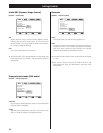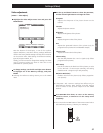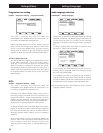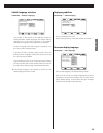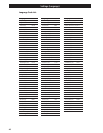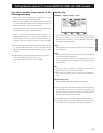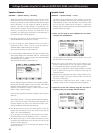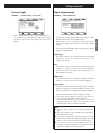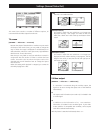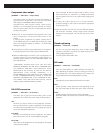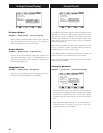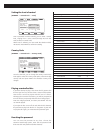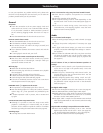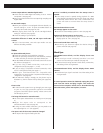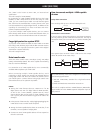
45
ENGLISH
Component video output
[GENERAL q Video Out q Comp. Video]
This setting allows the selection of interlaced (Interlace) or
progressive-scan (Progressive) video from the component
video outputs (COMPONENT VIDEO and D1/D2).
Progressive-scan video provides a better, clearer picture.
However, it is not supported by every television or monitor,
and you should ensure that this is supported fully before
turning on this option.
<
When your TV isn’t compatible with progressive scan, never
select “Progressive”. No picture will be shown on the
monitor.
In case you select “Progressive” by mistake, connect your TV
via the VIDEO OUT jack or S-VIDEO jack to display the Setup
menu and change the setting to “Interlace”, or initialize the
settings (see page 7).
<
This setting has no effect on the HDMI terminal. See page 31
to output progressive-scan video from the HDMI terminal.
< When this HDMI output is turned on, even if progressive scan
has been selected for the component video outputs, an
interlaced signal is output from the COMPONENT VIDEO and
the D1/D2 terminals.
‘CONSUMERS SHOULD NOTE THAT NOT ALL HIGH
DEFINITION TELEVISION SETS ARE FULLY COMPATIBLE WITH
THIS PRODUCT AND MAY CAUSE ARTIFACTS TO BE
DISPLAYED IN THE PICTURE. IN CASE OF 525 OR 625
PROGRESSIVE SCAN PICTURE PROBLEMS, IT IS
RECOMMENDED THAT THE USER SWITCH THE CONNECTION
TO THE ‘STANDARD DEFINITION’ OUTPUT. IF THERE ARE
QUESTIONS REGARDING OUR TV SET COMPATIBILITY WITH
THIS MODEL 525p AND 625p DVD PLAYER, PLEASE
CONTACT OUR CUSTOMER SERVICE CENTER.’
PAL-NTSC conversion
[GENERAL q Video Out q PL-NT Conv.]
This allows you to play back and show NTSC discs on PAL
equipment, or the other way round. There are three options:
OFF
PAL discs can only be shown on PAL equipment, and NTSC
discs can only be shown on NTSC equipment. Use this setting
to produce the best possible picture, by playing each type of
disc on the appropriate equipment.
PAL>NTSC
PAL discs can be displayed on NTSC equipment. The bottom
part of the picture is cut off, and the height is elongated.
NTSC>PAL
NTSC discs can be played back on PAL equipment. The height
of the picture is reduced.
If the connected TV does not support PAL (or NTSC), do not
select “NTSC>PAL” (or “PAL>NTSC”) or setting screens could
not be accessed. If this is the case, restore factory settings (see
page 7).
< To enjoy the original picture as it is, set the PAL-NTSC
conversion setting to “OFF” and use TVs that are appropriate
for each type of disc.
< Since the number of frames per second is different between
PAL and NTSC standards, moving images, when converted
between the two standards, may not look the same as their
original.
Closed captioning
[GENERAL q Video Out q Caption]
The unit can play back DVD discs which include closed
captioning information and show the closed captions (on a
suitably-equipped television).
Turn this function either ON or OFF.
Still mode
[GENERAL q Video Out q Still Mode]
There are three options to enable different still modes for
DVD, depending on whether a movie or other type of video is
being played back. This setting determines the clearest still
picture obtained when the DVD playback is paused.
Auto
Automatically chooses between field and frame modes.
Field
Usually provides a sharp still picture. But depending on the
disc, the image might be shaky even when “Field” is selected.
Frame
Usually provides a better still picture with movie DVDs.
With video DVDs, the picture may be blurred when playback
is paused.




